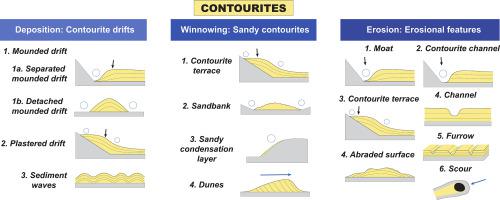Marine Geology ( IF 2.9 ) Pub Date : 2021-05-06 , DOI: 10.1016/j.margeo.2021.106502 Elda Miramontes , Antoine Thiéblemont , Nathalie Babonneau , Pierrick Penven , François Raisson , Laurence Droz , Stephan J. Jorry , Ruth Fierens , John W. Counts , Henriette Wilckens , Antonio Cattaneo , Gwenael Jouet

|
Oceanic currents can profoundly reshape the seafloor and even modify the characteristics of turbidite systems. Multiple erosional and depositional features directly formed by bottom currents (i.e. contourites), as well as by the interaction between bottom currents and turbidity currents or turbidite systems (i.e. mixed turbidite-contourite systems) have been identified in the Mozambique Channel (SW Indian Ocean) in multibeam bathymetry, seismic reflection data, sub-bottom profiler images and sediment cores. In this study, we characterise the morphology, stacking pattern and sedimentary characteristics of these sedimentary systems, and analysed the properties of bottom currents at these systems using a hydrodynamic numerical model. Modelled bottom currents are the highest at abraded surfaces and moats, but they also display a relatively high variability, suggesting that the observed erosion is not the result of a constant or persistent current but rather of episodes of intense circulation. Modelled bottom currents at contourite terraces are not significantly different from currents at related plastered drifts, where accumulation is enhanced. The formation of contourite terraces can thus not solely be explained by the mean oceanic circulation and eddies, implying that other processes such as internal waves may play a relevant role in their formation. Three different types of mixed turbidite-contourite systems were observed: one characterised by asymmetric channel-levee systems formed by the synchronous interaction of bottom currents and turbidity currents, one characterised by a phased interaction that resulted in the erosion of the channel flanks by bottom currents, and another one in which both synchronous and phased interaction played a relevant role in the evolution of the system. Finally, we propose a simplified classification of contourites that can be applied to any contourite system worldwide, and that comprises erosional and depositional features, including muddy and sandy contourite deposits.
中文翻译:

莫桑比克海峡(印度洋西南部)的共形体和混浊-混浊-共形体系统:几何形状,沉积物特征与模拟海流之间的联系
洋流可以深刻地重塑海床,甚至可以改变浊度系统的特征。在莫桑比克海峡(印度洋西南部)已经确定了由海底洋流(即等高线岩)以及海底洋流与浊流或浊度系统(即混浊-云母-杂岩系统)之间的相互作用直接形成的多种侵蚀和沉积特征。在多波束测深,地震反射数据,地下剖面图和沉积岩心中。在这项研究中,我们表征了这些沉积系统的形态,堆积模式和沉积特征,并使用流体力学数值模型分析了这些系统底流的特性。在磨损的表面和at沟处,模型化的底部电流最高,但是它们还表现出相对较高的可变性,表明观察到的侵蚀不是恒定或持续电流的结果,而是剧烈循环的结果。在等高线阶地上模拟的底部电流与在相关的抹灰漂移处的电流没有显着不同,在相关抹灰漂移处,累积得到了增强。因此,不能仅用平均海洋环流和涡旋来解释等高线阶地的形成,这意味着诸如内浪之类的其他过程可能在其形成过程中起着重要的作用。观察到三种不同类型的混浊-轮廓混浊系统:一种是由底部电流和混浊电流的同步相互作用形成的不对称通道-堤坝系统,一个特征是分阶段的相互作用会导致底部电流受到沟道电流的侵蚀,而另一个特征是同步和分阶段的相互作用都在系统的演化中起着重要的作用。最后,我们提出了一种简化的轮廓石分类方法,可以将其应用于全世界的任何轮廓器体系,并且包括侵蚀和沉积特征,包括泥泞和含沙的轮廓器矿床。



























 京公网安备 11010802027423号
京公网安备 11010802027423号